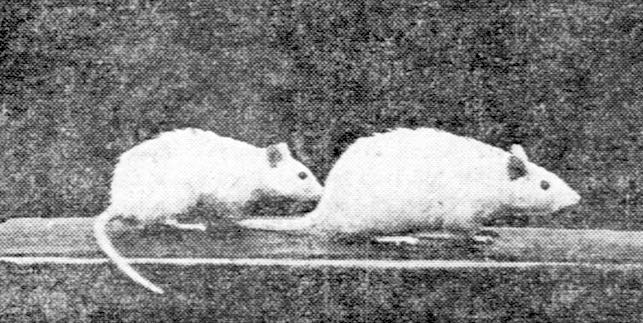
In a time before there was the internet, gaming consoles, Netflix, and smartphones, people had to find other ways to amuse themselves. Sure, there were books, dogs, and eventually the radio, but people still sought out odd ways to use up their free time. One of the more humorous things they did was tame rats. A quick search through old newspapers and periodicals shows that rats were really popular as pets during the 1800s and early 1900s. While some women claimed that they were at first uneasy about having a pet rat in the home, most of the women quickly adapted to truly loving the rat their kids brought in and tamed. Men, too, loved their rats and would set about teaching their little companions new tricks. Of course, if they weren’t playing with them as pets, then they were trying to get rid of them as pests, which led to numerous comical accounts of rats outsmarting men.

The Morphine Eater’s Loss
In 1879, a strange story hit the newspapers in the United States about a woman, described as a “morphine eater”, and the loss of her pet rat. The woman was visiting her father in Syracuse, New York and, while under the influence of morphine, her pet white rat escaped from the bosom of her dress where she kept it. The rat was killed by some men in the market, leaving the woman distraught. She immediately offered a reward of $100 (a lot of money for those times) for a new white rat and was returning to New York City in the hopes of getting the new companion. According to the newspaper report, “Her father says the rat was perfectly tame, and devoted to its mistress, who is rational upon all other subjects except this pet and morphine or opium.” [SOURCE 1]
Norfolk Jack
Sir Henry Rider Haggard wrote a variety of adventure novels in the late 1800s. His most popular works included King Solomon’s Mines, Morning, and, my personal favorite, She. He was also known to have a pet rat as his constant companion. The large rat, aptly named Jack, had full run of Haggard’s residence in Norfolk, but spent most of its time with Haggard in the study room. People who met Jack were amazed at the rat’s affection for Haggard. He would answer the writer’s calls and spend hours watching the master at work on his novels. [SOURCE 2]
A Better Rat Trap
An interesting story about the cunningness of city rats reported that a prominent hotel in the Philadelphia area had a major rat problem. An observer noticed two men struggling to move a mass of sharp, tangled tin clippings into the basement of the hotel. When the observer asked the men what they were doing, one responded that the tin clippings, brought over from the canning factory, were for the rats. He went on to say, “We use it for rats. I mean the big, grey fellows with whiskers. The hotel rat is bigger, bolder, and wiser than any other rat. He laughs at traps, fattens on poison, and the killing or chasing of dogs, cats, and ferrets is his pet diversion.” The hotel had tried other methods for getting rid of the rats, from closing up the rat holes to filling them with broken glass. Each time, the rats worked their way through the obstacles and returned to the hotel. With the mass of tin clippings, the hotel hoped that the metal was too heavy for the rats to move and that it would be impossible for them to chew through the metal. [SOURCE 3]
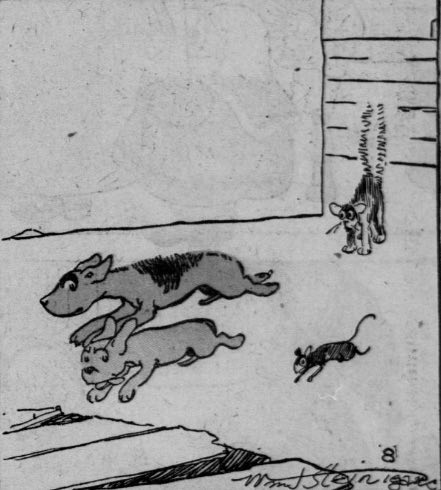
Bus Driver’s Rat
Everyone needs a gimmick in life and for one London omnibus driver, that gimmick was a baby rat he found while moving about some hay in a loft. The man pitied the tiny little rat and picked him up to take him home to his family. His children immediately loved the rat, as children do, and it was soon named Ikey. The rat grew up to be extremely tame and had full run of the house. The driver who found him trained the rat to do tricks, such as stand on its hind legs to beg and jump through a little hoop. He even made a tiny cart for Ikey, complete with a harness. Soon, Ikey was trained to jump into the driver’s overcoat and go to work with the omnibus driver where Ikey was in charge of guarding the driver’s lunch sack. It was reported that if anyone tried to steal the drivers lunch, Ikey would jump out of hiding and lunge toward the thief. [SOURCE 4]
Flagged
People in the early 1900s were fascinated by the rat’s ability to learn new things. In this story, a man was giving a birthday party for his son. During the preparations, he went to raise the flag on his 30-foot pole when the rope broke. None of the boys were allowed to climb up the pole because it wasn’t sturdy enough to hold them, so one of the boys ran back home and returned with some twine and his pet rat. The boy coaxed the rat to run up the pole with the twine, but once at the top, the rat didn’t know what to do next. The rat was called back down and an extra pulley system was brought out. The boy spent a few minutes teaching the rat how to put the string through the pulley. When they were done, the rat went back up the pole and threaded the twine through the opening in the pulley, bringing the end back down to the awaiting crowd. The story amazed everyone at the party and in September of 1907, the story of this intelligent rat appeared in the papers. [SOURCE 5]
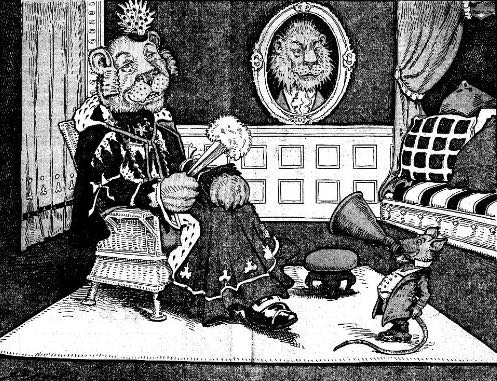
The Lion and the Rat
According to folklore, lions are gentle with the smallest of creatures. This was especially true of a lion named Leo who was known to keep small pets of his own. His trainer, Professor Edward Darling, claimed that Leo had many small friends, including a rat. While Leo was on a ship, going from London to Batavia, Leo befriended a ship rat. The rat would visit Leo in his cage every day and run across his large paws to play with him. The professor tried to capture the rat in the hopes of keeping it as a pet for Leo, but Leo became upset with the professor for trying to cage his friend. Professor Darling failed to catch the rat before they had reached their destination and Leo lost his friend. [SOURCE 6]
Sailor Rat
In an 1899 newspaper article there is a surprising story about a stowaway rat on board a ship. While this may just be a tall tale told among sailors, the story was reported as actual news. Apparently a rat was caught on board a British naval vessel. It was thrown overboard alive and a large gull that had been following the ship for kitchen scraps thrown overboard took a dive at the rat. A vicious fight between the rat and the gull ended when the rat bit the gull in the neck and killed it. The dead bird’s body floated on the water and the rat is said to have crawled up onto the bird’s back and lift the dead bird’s wing up like a sail. According to the storyteller, the rat was last seen sailing its way back to shore on board the bird. [SOURCE 3]
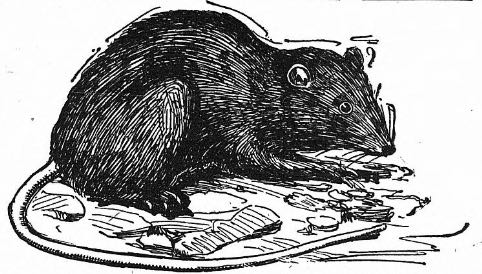
Prison Buddy
It was reported in the summer of 1877 that an arsonist by the name of Kennedy was pardoned from state prison. Kennedy, no doubt relieved to get out of prison, changed into his street clothes before remembering his cell companion. He asked an officer if he could go back to his cell to retrieve the rat, but when he was taken back to his former cell the rat ran and hid from him. Kennedy became upset because his rat would not get near him when he called to him. The officer suggested that maybe the rat didn’t recognize Kennedy in his street clothes. Kennedy put his prison jacket back on and sure enough the rat came to him. Kennedy left prison with his cell mate in hand. [SOURCE 7]
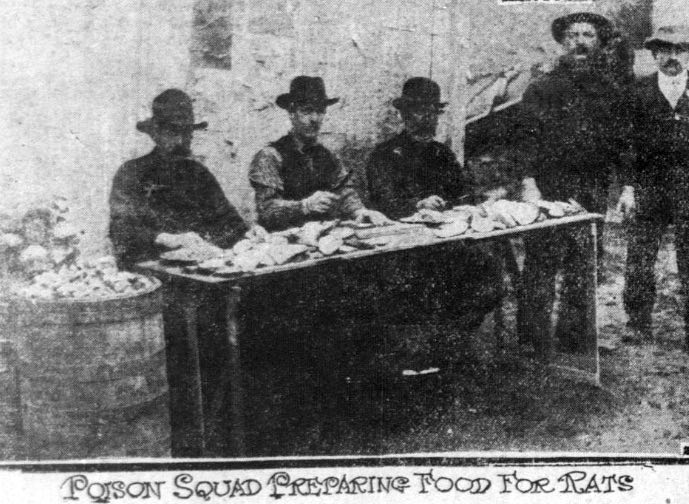
ERAT
Witty stories that may or may not have been true were passed around long before there was the internet and viral content. In 1911, one such story hit the newspapers. Although there are no details as to the names of people and places, the story was reported as fact. According to the report, an old college had a pet rat that all the students loved. One morning, the rat was found dead. Everyone went into mourning for the dear rodent and an obituary was supposedly written for it. It was rumored that the Dollar-a-Word Magazine accepted and paid for a copy of the rat’s obituary which turned out to be a single word: ERAT, meaning “it was” in Latin. [SOURCE 8]
Caspar
Caspar was a stage actor. The white rat had appeared before thousands of people on the stage and was apparently well known in certain circles. For his retirement, Caspar was given as a gift to the recorder at the University of Pennsylvania, George E. Nitzsche. Caspar eventually became ill and began to wheeze and cough. A medical authority from the Wistar Institute of Anatomy was called in and diagnosed poor Caspar with pneumonia. Caspar was given three weeks to live. While there is no followup article on Caspar, it is amazing that a rat could be so loved as to have his poor health and declining well being reported in the newspaper in 1920. [SOURCE 9]

